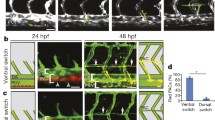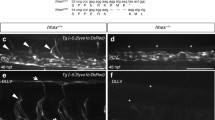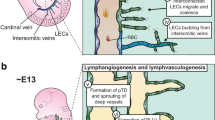Abstract
In contrast to the extensive molecular and functional characterization of blood vascular endothelium, little is known about the mechanisms that control the formation and lineage-specific differentiation and function of lymphatic vessels. The homeobox gene Prox1, the vertebrate homologue of the Drosophila prospero gene, has been recently identified to be required for the induction of lymphatic vascular development from preexisting embryonic veins, and studies in Prox1-deficient mice have confirmed Florence Sabin's original hypothesis about the origin of the lymphatic vascular system from embryonic veins. The recent establishment of cell culture models for the selective propagation of blood vascular and lymphatic endothelial cells, together with the findings that these cells maintain their lineage-specific differentiation in vitro, has led to the discovery that Prox1 expression is sufficient to induce a lymphatic phenotype in blood vascular endothelium. Ectopic expression of Prox1 downregulated blood vascular-associated genes and also upregulated some of the known lymphatic endothelial cell markers. Together, these studies suggest that the blood vascular phenotype represents the default endothelial differentiation and they identify an essential role of Prox1 in the program specifying lymphatic endothelial cell fate.



Similar content being viewed by others
References
Asellius G (1627) De lactibus sive lacteis venis. Mediolani, Milan
Chu-Lagraff Q, Wright DM, McNeil LK, Doe CQ (1991) The prospero gene encodes a divergent homeodomain protein that controls neuronal identity in Drosophila. Development Suppl:79–85
Demidenko Z, Badenhorst P, Jones T, Bi X, Mortin MA (2001) Regulated nuclear export of the homeodomain transcription factor Prospero. Development 128:1359-1367
Doe CQ (1992) Molecular markers for identified neuroblasts and ganglion mother cells in the Drosophila central nervous system. Development 116:855–863
Doe CQ, Chu-LaGraff Q, Wright DM, Scott MP (1991) The prospero gene specifies cell fates in the Drosophila central nervous system. Cell 65:451–464
Duncan MK, Cui W, Oh DJ, Tomarev SI (2002) Prox1 is differentially localized during lens development. Mech Dev 112:195–198
Gunn MD, Tangemann K, Tam C, Cyster JG, Rosen SD, Williams LT (1998) A chemokine expressed in lymphoid high endothelial venules promotes the adhesion and chemotaxis of naive T lymphocytes. Proc Natl Acad Sci U S A 95:258–263
Hassan B, Li L, Bremer KA, Chang W, Pinsonneault J, Vaessin H (1997) Prospero is a panneural transcription factor that modulates homeodomain protein activity. Proc Natl Acad Sci U S A 94:10991–10996
Hirakawa S, Hong YK, Harvey N, Schacht V, Matsuda K, Libermann T, Detmar M (2003) Identification of vascular lineage-specific genes by transcriptional profiling of isolated blood vascular and lymphatic endothelial cells. Am J Pathol 162:575–586
Hirata J, Nakagoshi H, Nabeshima Y, Matsuzaki F (1995) Asymmetric segregation of the homeodomain protein Prospero during Drosophila development. Nature 377:627–630
Hong YK, Harvey N, Noh YH, Schacht V, Hirakawa S, Detmar M, Oliver G (2002) Prox1 is a master control gene in the program specifying lymphatic endothelial cell fate. Dev Dyn 225:351–357
Huntington GS, McClure CFW (1910) The anatomy and development of the jugular lymph sac in the domestic cat (Felis domestica). Am J Anat 10:177–311
Jackson DG, Prevo R, Clasper S, Banerji S (2001) LYVE-1, the lymphatic system and tumor lymphangiogenesis. Trends Immunol 22:317–321
Jacobs JR (1993) Perturbed glial scaffold formation precedes axon tract malformation in Drosophila mutants. J Neurobiol 24:611–626
Jan YN, Jan LY (1998) Asymmetric cell division. Nature 392:775–778
Kaipainen A, Korhonen J, Mustonen T, van HV, Fang GH, Dumont D, Breitman M, Alitalo K (1995) Expression of the fms-like tyrosine kinase 4 gene becomes restricted to lymphatic endothelium during development. Proc Natl Acad Sci U S A 92:3566–3570
Kauffmann RC, Li S, Gallagher PA, Zhang J, Carthew RW (1996) Ras1 signaling and transcriptional competence in the R7 cell of Drosophila. Genes Dev 10:2167–2178
Knoblich JA, Jan LY, Jan YN (1995) Asymmetric segregation of Numb and Prospero during cell division. Nature 377:624–627
Kriehuber E, Breiteneder GS, Groeger M, Soleiman A, Schoppmann SF, Stingl G, Kerjaschki D, Maurer D (2001) Isolation and characterization of dermal lymphatic and blood endothelial cells reveal stable and functionally specialized cell lineages. J Exp Med 194:797–808
Li L, Vaessin H (2000) Pan-neural Prospero terminates cell proliferation during Drosophila neurogenesis. Genes Dev 14:147–151
Maekinen T, Veikkola T, Mustjoki S, Karpanen T, Catimel B, Nice EC, Wise L, Mercer A, Kowalski H, Kerjaschki D, Stacker SA, Achen MG, Alitalo K (2001) Isolated lymphatic endothelial cells transduce growth, survival and migratory signals via the VEGF-C/D receptor VEGFR-3. EMBO J 20:4762–4773
Manning L, Doe CQ (1999) Prospero distinguishes sibling cell fate without asymmetric localization in the Drosophila adult external sense organ lineage. Development 126:2063–2071
Matsuzaki F, Koizumi K, Hama C, Yoshioka T, Nabeshima Y (1992) Cloning of the Drosophila prospero gene and its expression in ganglion mother cells. Biochem Biophys Res Commun 182:1326–1332
Myster DL, Duronio RJ (2000) To differentiate or not to differentiate? Curr Biol 10:R302–304
Oliver G, Detmar M (2002) The rediscovery of the lymphatic system: old and new insights into the development and biological function of the lymphatic vasculature. Genes Dev 16:773–783
Oliver G, Sosa-Pineda B, Geisendorf S, Spana EP, Doe CQ, Gruss P (1993) Prox 1, a prospero-related homeobox gene expressed during mouse development. Mech Dev 44:3–16
Petrova TV, Makinen T, Makela TP, Saarela J, Virtanen I, Ferrell RE, Finegold DN, Kerjaschki D, Yla-Herttuala S, Alitalo K (2002) Lymphatic endothelial reprogramming of vascular endothelial cells by the Prox-1 homeobox transcription factor. EMBO J 21:4593–4599
Podgrabinska S, Braun P, Velasco P, Kloos B, Pepper MS, Jackson DG, Skobe M (2002) Molecular characterization of lymphatic endothelial cells. Proc Natl Acad Sci U S A 99:16069–16074
Rusznyak I, Foeldi M, Szabo G (1967) Lymphatics and lymph circulation. Pergamon, Oxford
Sabin FR (1902) On the origin of the lymphatic system from the veins and the development of the lymph hearts and thoracic duct in the pig. Am J Anat 1:367–391
Sabin FR (1904) On the development of the superficial lymphatics in the skin of the pig. Am J Anat 3:183–195
Schaefer JJ, Oliver G, Henry JJ (1999) Conservation of gene expression during embryonic lens formation and cornea-lens transdifferentiation in Xenopus laevis. Dev Dyn 215:308–318
Schneider M, Othman-Hassan K, Christ B, Wilting J (1999) Lymphangioblasts in the avian wing bud. Dev Dyn 216:311–319
Skobe M, Detmar M (2000) Structure, function and molecular control of the skin lymphatic system. J Invest Dermatol Symp Proc 5:14–19
Sosa-Pineda B, Wigle JT, Oliver G (2000) Hepatocyte migration during liver development requires Prox1. Nat Genet 25:254–255
Spana EP, Doe CQ (1995) The prospero transcription factor is asymmetrically localized to the cell cortex during neuroblast mitosis in Drosophila. Development 121:3187–3195
Tomarev SI, Sundin O, Banerjee-Basu S, Duncan MK, Yang JM, Piatigorsky J (1996) Chicken homeobox gene Prox 1 related to Drosophila prospero is expressed in the developing lens and retina. Dev Dyn 206:354–367
Tomarev SI, Zinovieva RD, Chang B, Hawes NL (1998) Characterization of the mouse Prox1 gene. Biochem Biophys Res Commun 248:684–689
Vaessin H, Grell E, Wolff E, Bier E, Jan LY, Jan YN (1991) Prospero is expressed in neuronal precursors and encodes a nuclear protein that is involved in the control of axonal outgrowth in Drosophila. Cell 67:941–953
Wigle JT, Oliver G (1999) Prox1 function is required for the development of the murine lymphatic system. Cell 98:769–778
Wigle JT, Harvey N, Detmar M, Lagutina I, Grosveld G, Gunn MD, Jackson DG, Oliver G (2002) An essential role for Prox1 in the induction of the lymphatic endothelial cell phenotype. EMBO J 21:1505–1513
Wilting J (2001) New perspectives in lymphangiogenesis research. Microsc Res Tech 55:59–60
Wilting J, Papoutsi M, Othman-Hassan K, Rodriguez-Niedenfuhr M, Prols F, Tomarev SI, Eichmann A (2001) Development of the avian lymphatic system. Microsc Res Tech 55:81–91
Witte MH, Bernas MJ, Martin CP, Witte CL (2001) Lymphangiogenesis and lymphangiodysplasia: from molecular to clinical lymphology. Microsc Res Tech 55:122–145
Zinovieva RD, Duncan MK, Johnson TR, Torres R, Polymeropoulos MH, Tomarev SI (1996) Structure and chromosomal localization of the human homeobox gene Prox 1. Genomics 35:517–522
Author information
Authors and Affiliations
Corresponding author
Rights and permissions
About this article
Cite this article
Hong, YK., Detmar, M. Prox1, master regulator of the lymphatic vasculature phenotype. Cell Tissue Res 314, 85–92 (2003). https://doi.org/10.1007/s00441-003-0747-8
Received:
Accepted:
Published:
Issue Date:
DOI: https://doi.org/10.1007/s00441-003-0747-8




